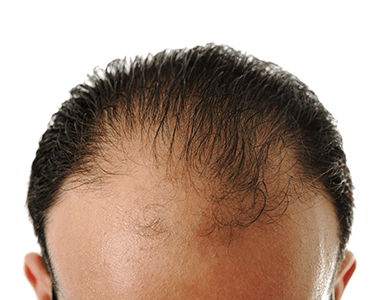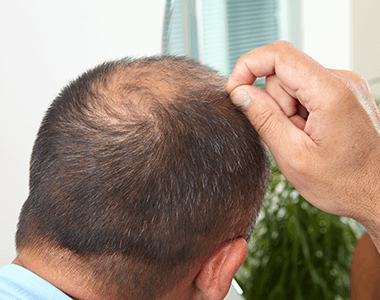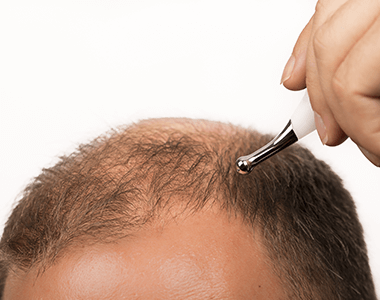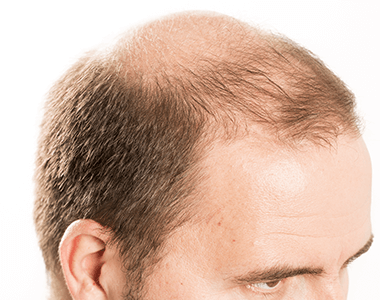Male Pattern Hair Loss
What is male pattern hair loss?
It’s the gradual loss or thinning of hair across parts or all of the scalp. As the name implies, it occurs mostly, but not exclusively, in men. Male pattern hair loss (MPHL) is a form of androgenetic alopecia. Some sufferers may see early signs of MPHL in their early 20s, and it will develop according to a predictable pattern. Although the rate of progression is variable, the earlier it appears the more rapidly it tends to develop.

What causes it?
MPHL begins in men only after puberty. It’s triggered by the puberty-associated rise in androgen hormones in the body. MPHL predominantly affects men because androgens are the hormones responsible for male sexual development.
In addition, MPHL is a condition that can be inherited from both parents. It’s therefore a genetic trait in some individuals, and for that reason is also referred to as androgenetic alopecia.
Two male hormones, in particular, stimulate hair growth after puberty. They’re called testosterone and dihydrotestosterone (DHT).
DHT is produced from testosterone by an enzyme called type 2 5 alpha-reductase. If there’s too much of this enzyme, and so too much DHT, the hair follicle can be damaged.The follicle shrinks as a result and in turn this slows down hair production. This process is called miniaturisation. In fact, over a period of time the follicle may cease to produce any significant hair growth at all.
The over-production of DHT is a trait that can be inherited, which is why is it’s regarded as a genetic condition. If a man’s grandfather, father or brothers lost their hair early, then there is a strong chance he will too. If there is a history of hair loss on both sides of the family, then the chances are even stronger.
Clinical features and progression of MPHL
The progression of MPHL has an element of predictability about it. This was charted first by Dr James Hamilton (in the 1950s) and later revised by Dr O’Tar Norwood (in the 1970s) to become what is today called the Hamilton-Norwood scale.
Within this scale, there are alternative routes of progression, depending on how the MPHL first shows itself. Each of the routes is categorised from stage 1 (the earliest) to stage 7 (the latest).
The alternative routes are as follows:

Typical pattern: : Bi-temporal (both sides) receding, followed by vertex (crown) hair loss, whereby the two areas of hair loss converge
Vertex pattern: Vertex hair loss begins soon after temporal receding, then progresses as a typical pattern
Anterior pattern: Frontal receding, moving backward to the vertex, leaving the classic ‘horseshoe-shaped’ perimeter of hair
Note: The anterior pattern diverges from the typical pattern and is therefore designated numerically as stage 2a through to 5a. In the case of the vertex pattern of hair loss, stage 2 diverges from the typical pattern as vertex hair loss progresses at an earlier stage.

Why see a trichologist?
A trichologist will be able to make or confirm a diagnosis of MPHL, and will be able to recommend the appropriate action to take. This may take the form of seeing a GP and trying minoxidil or finasteride to improve hair growth.
Treatment
There is no cure for MPHL. However there are 2 drug treatments which, if applied regularly, can slow its progress in some cases. These are: minoxidil, a cream that is applied topically to the scalp, or the oral administration of a drug called finasteride. There is a risk of side effects with both drugs.
Their effect only lasts while the treatment is being used and it is important that any treatment is started early in the progress of the condition, before the changes become too severe.
Also, there are other, more radical options that include procedures such as follicluar unit extraction (FUE). Although expensive, this procedure can be effective.
More facts
Some men affected by the onset of MPHL may seek a surgical solution rather than a medical one. Hair harvesting, or hair transplantation, is a procedure which involves the removal of healthy, growing hair and implanting it in areas of the scalp where hair growth has slowed or ceased. Hairs, including the follicles, are taken from what is known as the ‘donor site’, usually the sides or back of the head where the hair is still thick. These are then placed into incisions made in the bald or thinning areas of the scalp. Antibiotics are used to combat infection.

FAQ's
[otw-bm-list id=”11″]
Case Studies
[otw-bm-list id=”12″]